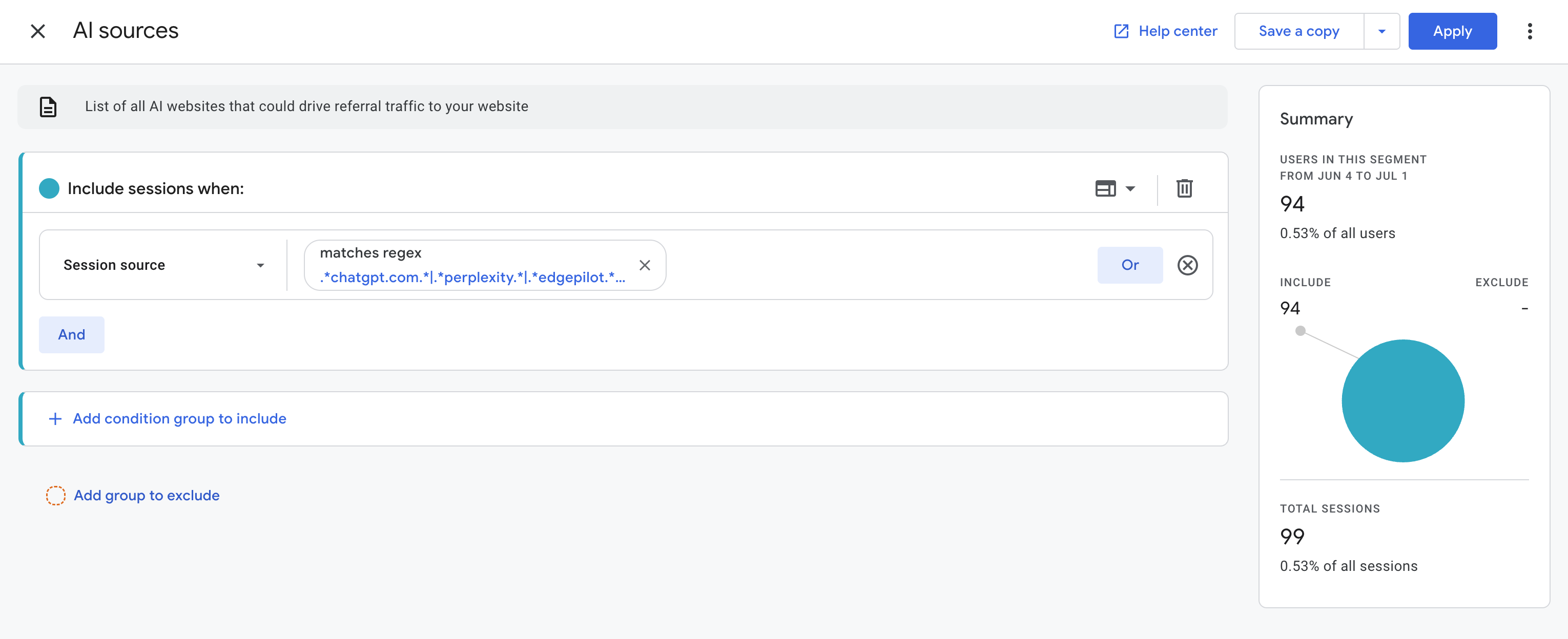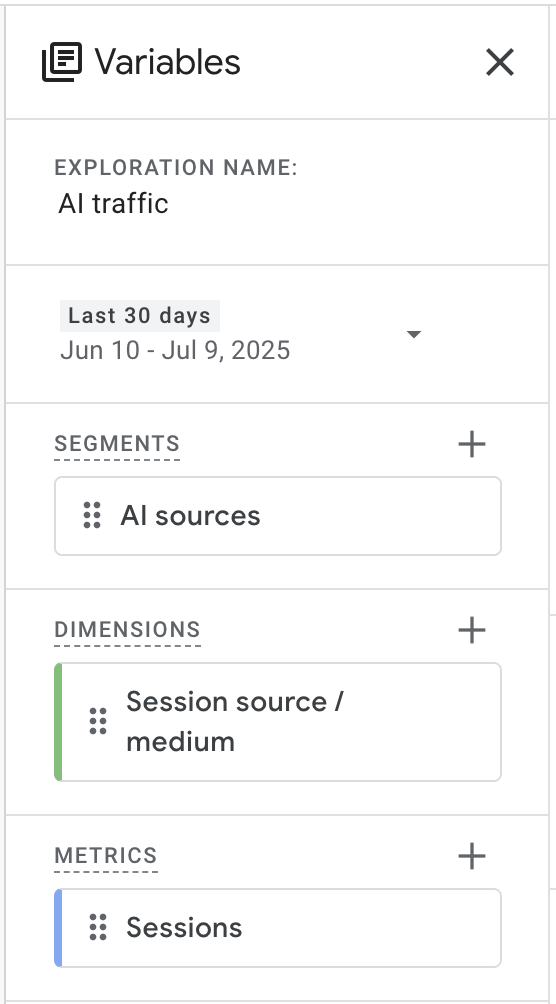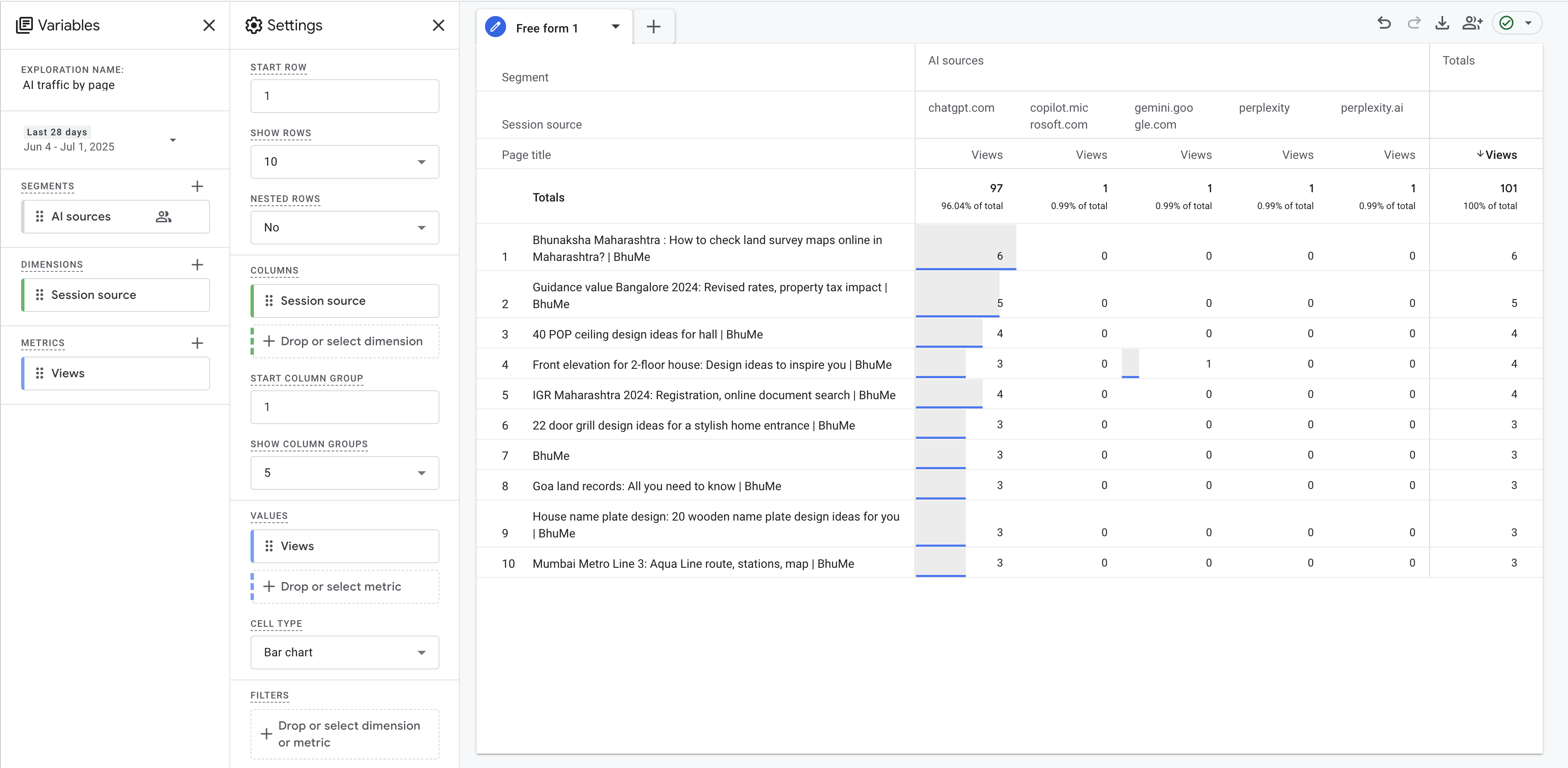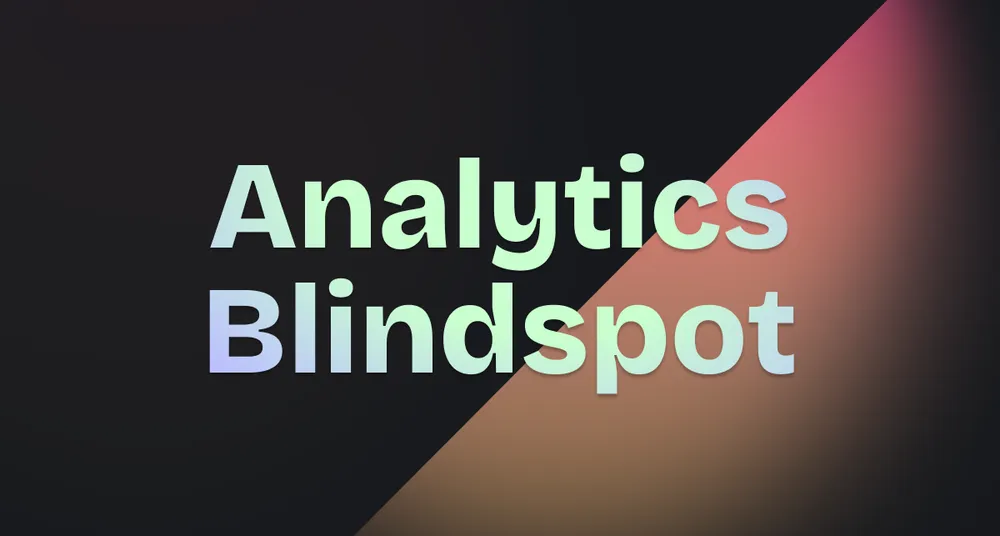AI Referred Traffic Tracking in GA4 - Complete Setup Guide for Marketing Teams
Why This Matters
Automated agents now comprise over 50% of web traffic, but traditional analytics can’t see them.¹ AI systems from ChatGPT, Claude, Perplexity, and Google crawl your site daily, analyze your content, and influence human visitors - but this entire interaction layer is invisible to standard tracking on google analytics.
The business impact is measurable: Companies report up to 34.5% traffic declines for top ranked pages where AI Overviews appear, while others gain citation advantages.² With Google’s AI mode rolling out globally in Q3 2025, marketing teams need AI traffic visibility before the acceleration phase begins.
Your mission: Implement complete AI traffic tracking within 7 days to restore attribution accuracy and enable optimization for AI-driven discovery and conversion.
What This Doesn’t Cover
AI crawler activity that traditional analytics tools miss, showing you which AI platforms index your content, how often they access your pages, and which content performs best in AI-generated responses. Traditional web analytics tools rely on JavaScript and cookies, making them blind to AI bot traffic. We can solve this by analyzing server-side logs to identify and track AI crawlers from major platforms. Need help? Reach out on my calendar Calendar Link
Implementation Timeline: 7-Day Sprint
Step 1: Foundation Setup
- Configure GA4 for basic AI source tracking
- Establish baseline metrics
- Set up channel groups and custom dimensions
Step 2: Advanced Config
- Document current blind spots
- Establish conversion tracking for AI-referred traffic
- Create executive reporting dashboards
Step 3: Specialized Tools
- Evaluate and deploy AI traffic analytics platforms
- Configure crawler detection and human attribution
Step 4: Optimization & Reporting
- Create content optimization frameworks
- Label Content as Open / Gated / Licensed
- Present findings and recommendations to executives
Part 1: GA4 Basic Configuration
The Problem: Your AI Traffic is Hidden in “Referral” Data
Right now, your Google Analytics is lumping AI platform traffic with general referrals. When someone finds your content through ChatGPT, Perplexity, or Claude and clicks through to your site, GA4 labels it as generic “referral” traffic. You’re losing attribution on some of your highest-intent visitors.
Important: This guide tracks human visitors who come to your website from AI platforms. It does not track AI bots that crawl your content without sending visitors to your site - that’s invisible traffic serving AI responses directly to users.
What You’ll Accomplish
By the end of this setup, you’ll see exactly:
- How many visitors come from each AI platform
- Which AI sources convert best
- How AI-referred traffic performs vs. other channels
- Weekly growth trends in AI discovery
Time required: 15 minutes for basic setup
Step 1: Create Your AI Traffic Segment
Why start here: Before creating permanent tracking, we need to see your current AI traffic baseline.
- Open Google Analytics 4 → Click Explore
- Start a blank exploration
- Add these elements:
- Dimension: Session Source/Medium
- Metric: Sessions
- Create your AI segment:
- Click Segments → Create new segment
- Select Session segment
- Name: “AI Sources”
- Add condition: Session Source, Matches regex
- Paste this regex pattern:
.*chatgpt\.com.*|.*perplexity.*|.*edgepilot.*|.*edgeservices.*|.*copilot\.microsoft\.com.*|.*openai\.com.*|.*gemini\.google\.com.*|.*nimble\.ai.*|.*iask\.ai.*|.*claude\.ai.*|.*aitastic\.app.*|.*bnngpt\.com.*|.*writesonic\.com.*|.*copy\.ai.*|.*chat-gpt\.org.*

- Save to property (this lets you reuse the segment)
- Click Apply
The left panel on your exploration should look like this:

What you’ll see: Your exploration now shows only AI platform traffic. Most marketing teams discover they have significant AI sources they couldn’t see before - traffic that was previously misclassified as generic referrals.
Step 2: Analyze AI Traffic Growth
Goal: Understand your AI discovery trends to measure future optimization impact.
- In your exploration, change visualization to line chart
- Set breakdown dimension: Session Source/Medium
- Time range: Last 90 days
- Granularity: Week (for cleaner trend view)
Take note: Which AI platforms send you the most traffic? When did AI traffic start appearing? This becomes your baseline.

Step 3: Analyze AI Traffic by page
Goal: Understand which pages do humans referred by AI assistants visit.
- Create a new exploration, choose visualization to Table
- Set Segment Comparisons: AI Sources
- Set Row and Column for the Table: Select Page Title as Rows and Session Source as Columns
- Set Values: Set “Views” as the values
- Time range: Last 90 days
Take note: Which AI platforms send you the most traffic? When did AI traffic start appearing? This becomes your baseline.

Step 4: Create Permanent AI Channel Group
Why this matters: Segments are great for analysis, but channel groups give you permanent, ongoing visibility in all GA4 reports.
- Go to Admin → Channel groups (under Data display)
- Create new channel group: “Analytics with AI Tracking”
- Add new channel:
- Channel name: “AI Platforms”
- Conditions: Source, matches regex
- Use the same regex pattern from Step 1
- Critical: Click Reorder and move “AI Platforms” above “Referral”
- This ensures AI traffic gets properly categorized instead of falling into generic referrals
- Save changes
Data collection starts immediately - you’ll see results within 24 hours.
Step 5: View AI Traffic in Traffic Acquisition Report
Once data collection begins:
- Go to Reports → Acquisition → Traffic Acquisition
- Change channel group dropdown to “Analytics with AI Tracking”
- You’ll now see “AI Platforms” as a distinct traffic source
Immediate Business Value
With this 15-minute setup, you now have:
- Attribution accuracy: AI traffic no longer hidden in “referral”
- Conversion tracking: See which AI platforms drive actual business results
- Optimization targets: Know where to focus content strategy efforts
- Executive reporting: Clear metrics on AI discovery impact
What’s Missing (And Why That’s Okay)
This setup tracks human visitors from AI platforms. It doesn’t capture:
- AI bots crawling your content for training
- Content used in AI responses without click-through
- AI recommendations that don’t result in visits
We can track it by accessing server side logs. Need help? Reach out on my calendar Calendar Link
These represent the larger “dark traffic” challenge, but tracking human AI referrals gives you the foundation for understanding AI’s impact on your business.
Next step: With baseline AI traffic data established, you can now optimize content for AI discovery and measure the impact on both AI platform visibility and human visitor quality.
- Monitor Q3 AI mode rollout impact on traffic patterns
- Expand tracking to emerging AI platforms as they launch
- Develop AI-specific content strategy based on performance data
- Share learnings with other teams (SEO, content, product)
- Iterate on measurement as AI discovery mechanisms evolve
Remember: This is infrastructure investment for the AI-first web. The technical setup is straightforward, but the strategic advantage compounds over time as you build a complete picture of how customers discover your brand in an AI-driven world.
References
¹ Netacea. “Hackers vs Crackers: Key Differences and Why They Are Both Extremely Dangerous.” 2025. / Imperva. “2025 Imperva Bad Bot Report.” 2025.
² Ahrefs. “AI Overviews Reduce Clicks by 34.5%.” 2025. / Reuters. “Chegg to lay off 22% of workforce as AI tools shake up edtech industry.” 2025.
³ Two Octobers case study referenced in “Tracking AI Traffic in GA4: A Step-by-Step Guide.”
⁴ Regex pattern compilation referenced from Larry Engel’s GA4 implementation guide.

Over 1 million companies just blocked AI crawlers after discovering automated agents comprise 50%+ of web traffic. With major publishers losing 30% of revenue and filing lawsuits, the economic model of digital marketing has fundamentally shifted. What should an executive do?
